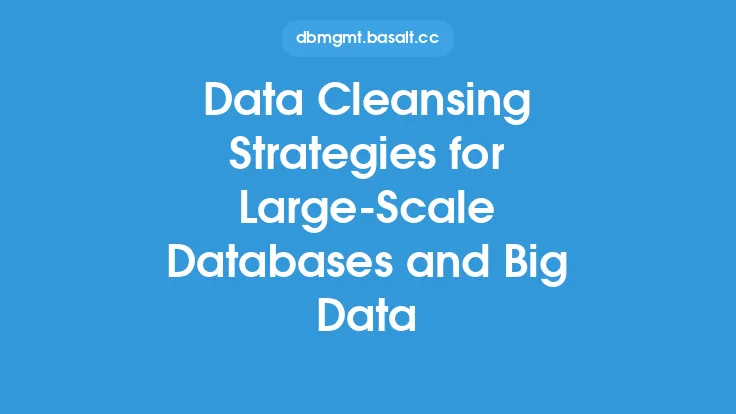When managing large-scale databases, it's essential to have a robust auditing strategy in place to ensure the security, integrity, and performance of the database. Database auditing involves tracking and monitoring all activities that occur within the database, including data modifications, user access, and system changes. This information can be used to identify potential security threats, troubleshoot performance issues, and ensure compliance with regulatory requirements.
Introduction to Database Auditing Strategies
A well-planned database auditing strategy should take into account the specific needs and requirements of the organization, including the type of data being stored, the level of security required, and the regulatory compliance requirements. There are several types of database auditing strategies, including native auditing, where the database management system (DBMS) provides built-in auditing capabilities, and external auditing, where a separate auditing tool or system is used to monitor database activities. The choice of auditing strategy will depend on the specific needs of the organization and the level of complexity required.
Types of Database Auditing
There are several types of database auditing, including:
- Statement auditing: This involves tracking and monitoring all SQL statements executed against the database, including SELECT, INSERT, UPDATE, and DELETE statements.
- Object auditing: This involves tracking and monitoring all changes made to database objects, including tables, indexes, and views.
- User auditing: This involves tracking and monitoring all user activities, including login and logout events, and changes made to user accounts.
- System auditing: This involves tracking and monitoring all system-level events, including startup and shutdown events, and changes made to system configuration.
Database Auditing Techniques
There are several database auditing techniques that can be used to monitor and track database activities, including:
- Logging: This involves recording all database activities in a log file, which can be used to track and monitor database events.
- Tracing: This involves tracking and monitoring all database activities in real-time, using a tracing tool or utility.
- Sniffing: This involves capturing and analyzing all network traffic to and from the database, using a network sniffer or protocol analyzer.
- Auditing tools: This involves using specialized auditing tools or software to monitor and track database activities, including native auditing tools provided by the DBMS, and external auditing tools provided by third-party vendors.
Best Practices for Database Auditing
To ensure effective database auditing, several best practices should be followed, including:
- Regularly review audit logs: Regularly reviewing audit logs can help identify potential security threats and performance issues.
- Implement a centralized auditing system: Implementing a centralized auditing system can help simplify the auditing process and provide a single point of control.
- Use automated auditing tools: Using automated auditing tools can help reduce the administrative burden of auditing and provide real-time monitoring and alerting capabilities.
- Test and validate auditing configurations: Testing and validating auditing configurations can help ensure that the auditing system is working correctly and providing accurate and reliable data.
Database Auditing and Compliance
Database auditing plays a critical role in ensuring regulatory compliance, including compliance with laws and regulations such as the General Data Protection Regulation (GDPR), the Health Insurance Portability and Accountability Act (HIPAA), and the Payment Card Industry Data Security Standard (PCI DSS). To ensure compliance, organizations should implement a robust auditing strategy that includes:
- Tracking and monitoring all database activities: Tracking and monitoring all database activities, including data modifications, user access, and system changes.
- Maintaining accurate and reliable audit logs: Maintaining accurate and reliable audit logs, including logs of all database activities, and logs of all system-level events.
- Providing audit logs to regulatory authorities: Providing audit logs to regulatory authorities, as required, to demonstrate compliance with regulatory requirements.
Database Auditing and Performance
Database auditing can also play a critical role in identifying and troubleshooting performance issues, including:
- Identifying resource-intensive queries: Identifying resource-intensive queries, including queries that are using excessive CPU, memory, or I/O resources.
- Tracking and monitoring database wait events: Tracking and monitoring database wait events, including wait events related to locking, I/O, and networking.
- Analyzing audit logs to identify performance trends: Analyzing audit logs to identify performance trends, including trends related to query execution, user activity, and system performance.
Challenges and Limitations of Database Auditing
While database auditing is an essential component of database administration, there are several challenges and limitations that should be considered, including:
- Performance overhead: Database auditing can introduce performance overhead, including overhead related to logging, tracing, and auditing.
- Data volume and complexity: Database auditing can generate large volumes of data, which can be complex and difficult to analyze.
- Security and access control: Database auditing requires careful consideration of security and access control, including ensuring that audit logs are secure and access-controlled.
Future of Database Auditing
The future of database auditing is likely to be shaped by several trends and technologies, including:
- Cloud-based auditing: Cloud-based auditing is likely to become more prevalent, as organizations move their databases to the cloud and require cloud-based auditing solutions.
- Artificial intelligence and machine learning: Artificial intelligence and machine learning are likely to play a larger role in database auditing, including using AI and ML to analyze audit logs and identify potential security threats.
- Real-time auditing: Real-time auditing is likely to become more prevalent, as organizations require real-time monitoring and alerting capabilities to respond quickly to security threats and performance issues.





